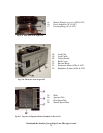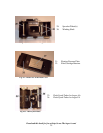Download this book for free at http://www.TheArgusA.com/
29
shutter. Keep in mind that the Argus View Finder shows slightly less than will appear on
the film negative; this was intentional and meant to compensate for aiming errors. The
camera must be held steady, resting against the cheek, and the pressure on the Trigger
should be gradual so that the camera is held as still as possible while the shutter is
operating. The secret of clear, sharp negatives with a “miniature” camera is firm holding
and steady shutter release. This is especially true when using shutter speeds of 1/50
th
of a
second and slower. To avoid the possibility of tremor and when light conditions warrant,
it is always advisable to use the highest possible shutter speed.
16. ADVANCE THE FILM IMMEDIATELY AFTER EACH EXPOSURE! The
instructions for this are located in Step 7. This is necessary to prevent either double
exposures or wasted film. The only way to avoid problems is to get into the habit of
advancing the film immediately after taking the picture.
Rewinding Finished Film
17. Ensure that when you are getting close to the end of the roll, you don’t tear the end of
the film out of the film cartridge while winding it. After 36 exposures, or whatever
number of exposures provided by the film, rewind it back into the film cartridge by
turning the Rewind Knob in the direction indicated. Make certain that as you rewind the
film, you do not prevent the Winding Knob or the Counter Dial from turning. If the
camera seems to be rewinding only one frame at a time, push the Counter Dial Release
towards the View Finder while rewinding.
18. Remove the Back Cover of the camera and pull the Rewind Knob on the bottom of
the camera as far out as it will go. Remove the film cartridge and replace the Back
Cover.
Using The Sunny/16 Rule
The best indicator of acceptable shutter speed/aperture settings is a light meter. If
you steadfastly refuse to purchase a light meter, or find yourself without one, use the
“Sunny/16” Rule.
The “Sunny/16” Rule states: on a sunny day with the aperture set at f/16, your
exposure time should be your film speed. For example, if you are using 200 ISO film,
you set the Shutter Speed to 200. You should open the aperture one stop if it is hazy, two
if it is cloudy, or three if it is in shadow. Close the aperture one stop if you are
photographing white sand or snow.
The “Sunny/16” Rule is not terribly accurate, but it works if there is no better
way.


















